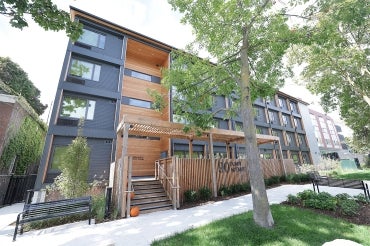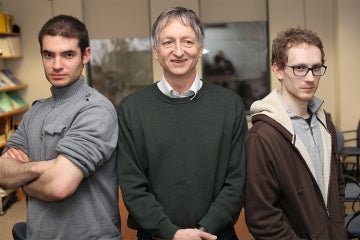'Housing-first' more effective than 'treatment-first' for addressing addiction, homelessness: Study

The Dunn House in Toronto, a partnership between government, the University Health Network and the United Way, is a social medicine housing initiative to provide safe, permanent, accessible and affordable homes to those experiencing homelessness (photo by Steve Russell/Toronto Star via Getty Images)
Published: July 11, 2025
A “housing-first” approach to addressing homelessness and addiction can reduce the likelihood of fatal overdoses and lower health-care costs, according to a new study from the University of Toronto.
The new paper, published in JAMA Network Open, uses mathematical modelling to show the impact of providing stable housing to people experiencing homelessness and opioid addiction.

“Homelessness, substance abuse disorders and a disconnect from healthcare services are all intertwined,” says study co-author Isabelle Rao, an assistant professor in U of T’s department of mechanical and industrial engineering in the Faculty of Applied Science & Engineering. “For example, homelessness increases the likelihood of developing an addiction, while addiction increases the likelihood of losing housing options.”
Approaches to treating these interconnected issues typically fall into two general categories: housing-first and treatment-first. Housing-first prioritizes providing permanent housing as quickly as possible, with other supportive services offered afterward. Treatment-first, by contrast, takes the opposite approach.
During the COVID-19 pandemic, opioid use surged and fentanyl became a leading cause of overdose deaths. This prompted Rao and her former adviser, Professor Margaret Brandeau of Stanford University, to create a dynamic mathematical model that incorporates housing – a key social determinant of health – into the analysis of the opioid crisis.
The model simulated treatment and health outcomes for 1,000 unhoused individuals with opioid addiction, both with and without the provision of stable housing. It included men and women across a range of ages and projected overdoses and deaths over five years, as well as lifetime health-care and housing costs, and quality-adjusted life years (QALYs).
The results showed that investing in stable housing for marginalized populations was cost-effective, improved health outcomes, increased participation in addiction treatment and saved lives.
“The most successful outcome in our analysis came when stable housing was provided,” says Rao. “This improved addiction treatment success and reduced mortality rates among individuals who had experienced homelessness.”
The team found that implementing the housing intervention reduced total overdoses and fatal overdoses over the five years by 11 per cent and nine per cent, respectively. The intervention cost US$96,000 per person and increased quality-adjusted life years by 3.59, resulting in an incremental cost of US$26,800 per QALY gained compared to the no-housing scenario. When factoring in savings to the criminal justice system, such housing programs may even save money.
“The results from the mathematical modelling demonstrate that providing stable housing is both life-saving and cost-effective,” says Rao. “This study has the potential to help inform local policies for funding and demonstrate the cost-effectiveness of housing-first programs.”
Rao and Brandeau have engaged with officials in California’s Santa Clara County, where Stanford University is located, to inform policies around homelessness. They are also seeking to do outreach with other local health communities and expand into Toronto – and are pursuing funding from the U.S. National Institutes of Health.
“I have always been invested in having an impact on policies to improve the lives of marginalized communities,” says Rao. “My engineering and mathematical background allows me to use modelling to inform critical decisions in public health. It’s very motivating to see the positive and long-term health-care and personal care impacts that stable housing can provide to people experiencing homelessness.”



